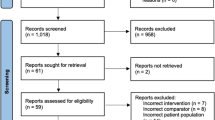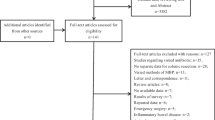Abstract
Purpose
Cecal intubation time (CIT) is an indicator for difficult colonoscopy which is associated with patients’ unpleasant experience as well as increased risk of complications. Several studies have attempted to identify predictors for prolonged CIT but those studies tended to be small which gave rise to inconsistent and underpowered results. This systematic review and meta-analysis was conducted to summarize all available data.
Methods
MEDLINE and EMBASE databases were searched through November 2017 for studies that investigated the factors for prolonged CIT. Only factors that were reported by at least three studies were included in the meta-analyses. Pooled mean difference (MD) and 95% confidence interval (CI) were calculated using random effects model. The between-study heterogeneity of effect size was quantified using the Q statistic and I2.
Results
A total of nine studies involving 7131 patients were included. A total of six factors were analyzed. Patients with older age (≥ 65 versus < 65), female sex (versus male), low body mass index (BMI) (< 25 versus ≥ 25 kg/m2), and poor bowel preparation (versus fair to good) had significantly longer CIT. The presence of diverticulosis and prior abdominal surgery were not significantly associated with prolonged CIT.
Conclusions
The current meta-analyses have demonstrated that old age, female sex, low BMI, and poor bowel preparation were the predictors for prolonged CIT.

Similar content being viewed by others
References
Torre LA, Bray F, Siegel RL, Ferlay J, Lortet-Tieulent J, Jemal A (2015) Global cancer statistics, 2012. CA Cancer J Clin 65:87–108
Arnold M, Sierra MS, Laversanne M, Soerjomataram I, Jemal A, Bray F (2017) Global patterns and trends in colorectal cancer incidence and mortality. Gut 66:683–691
Center MM, Jemal A, Smith RA, Ward E (2009) Worldwide variations in colorectal cancer. CA Cancer J Clin 59:366–378
Brenner H, Chang-Claude J, Rickert A, Seiler CM, Hoffmeister M (2012) Risk of colorectal cancer after detection and removal of adenomas at colonoscopy: population-based case-control study. J Clin Oncol 30:2969–2976
Pan J, Xin L, Ma YF, Hu LH, Li ZS (2016) Colonoscopy reduces colorectal cancer incidence and mortality in patients with non-malignant findings: a meta-analysis. Am J Gastroenterol 111:355–365
Schoenfeld PS, Cohen J (2013) Quality indicators for colorectal cancer screening for colonoscopy. Tech Gastrointest Endosc 15:59–68
Anderson JC, Messina CR, Cohn W, Gottfried E, Ingber S, Bernstein G, Coman E, Polito J (2001) Factors predictive of difficult colonoscopy. Gastrointest Endosc 54:558–562
von Renteln D, Robertson DJ, Bensen S, Pohl H (2017) Prolonged cecal insertion time is associated with decreased adenoma detection. Gastrointest Endosc 85:574–580
Barclay RL, Vicari JJ, Doughty AS, Johanson JF, Greenlaw RL (2006) Colonoscopic withdrawal times and adenoma detection during screening colonoscopy. N Engl J Med 355:2533–2541
Anderson JC, Gonzalez JD, Messina CR, Pollack BJ (2000) Factors that predict incomplete colonoscopy: thinner is not always better. Am J Gastroenterol 95:2784–2787
Bernstein C, Thorn M, Monsees K, Spell R, O’Connor JB (2005) A prospective study of factors that determine cecal intubation time at colonoscopy. Gastrointest Endosc 61:72–75
Hsieh Y-H, Kuo C-S, Tseng K-C, Lin H-J (2008) Factors that predict cecal insertion time during sedated colonoscopy: the role of waist circumference. J Gastroenterol Hepatol 23:215–217
Kawasato R, Hashimoto S, Shirasawa T, Goto A, Okamoto T, Nishikawa J, Sakaida I (2017) Correlation between obesity and metabolic syndrome-related factors and cecal intubation time during colonoscopy. Clin Exp Gastroenterol:10:1–10:7
Krishnan P, Sofi AA, Dempsey R, Alaradi O, Nawras A (2012) Body mass index predicts cecal insertion time: the higher, the better. Dig Endosc 24:439–442
Liang C-M, Chiu Y-C, Wu K-L, Tam W, Tai W-C, Hu M-L, Chou Y-P, Chiu KW, Chuah SK (2012) Impact factors for difficult cecal intubation during colonoscopy. Surg Laparosc Endosc Percutan Tech 22:443–446
Nagata N, Sakamoto K, Arai T, Niikura R, Shimbo T, Shinozaki M, Noda M, Uemura N (2014) Predictors for cecal insertion time: the impact of abdominal visceral fat measured by computed tomography. Dis Colon Rectum 57:1213–1219
Park H-J, Hong J-H, Kim H-S, Kim B-R, Park S-Y, Jo K-W, Kim J-W (2013) Predictive factors affecting cecal intubation failure in colonoscopy trainees. BMC Med Educ 13:5
Uddin FS, Iqbal R, Harford WV, Dunbar KB, Cryer BL, Spechler SJ, Feagins LA (2013) Prone positioning of obese patients for colonoscopy results in shortened cecal intubation times: a randomized trial. Dig Dis Sci 58:782–787
Higgins JP, Thompson SG, Deeks JJ, Altman DG (2003) Measuring inconsistency in meta-analyses. BMJ 327:557–560
Sterne JA, Egger M (2001) Funnel plots for detecting bias in meta-analysis: guidelines on choice of axis. J Clin Epidemiol 54:1046–1055
Akere A, Otegbayo JA (2016) Complete colonoscopy: impact of patients’ demographics and anthropometry on caecal intubation time. BMJ Open Gastroenterol 3:e000076
Jain D, Goyal A, Uribe J (2016) Obesity and Cecal intubation time. Clin Endosc 49:187–190
Lee HL, Eun CS, Lee OY, Jeon YC, Han DS, Sohn JH, Yoon BC, Choi HS, Hahm JS, Lee MH, Lee DH, Moon W, Kim SY (2009) Significance of colonoscope length in cecal insertion time. Gastrointest Endosc 69:503–508
Poniewierka E, Dudkowiak R, Marczynski W (2016) Impact of sex and body mass index on cecal intubation time. Is it a myth that colonoscopy is easier to perform in obese than lean people? J Med Sci 85:298–301
Khashab MA, Pickhardt PJ, Kim DH, Rex DK (2009) Colorectal anatomy in adults at computed tomography colonography: normal distribution and the effect of age, sex, and body mass index. Endoscopy 41:674–678
Sadahiro S, Ohmura T, Yamada Y, Saito T, Taki Y (1992) Analysis of length and surface area of each segment of the large intestine according to age, sex and physique. Surg Radiol Anat 14:251–257
Waye JD (2013) Difficult colonoscopy. Gastroenterol Hepatol (N Y) 9:676–678
Streett SE (2007) Endoscopic colorectal cancer screening in women: can we do better? Gastrointest Endosc 65:1047–1049
Saunders BP, Fukumoto M, Halligan S, Jobling C, Moussa ME, Bartram CI, Williams CB (1996) Why is colonoscopy more difficult in women? Gastrointest Endosc 43:124–126
Rowland RS, Bell GD, Dogramadzi S, Allen C (1999) Colonoscopy aided by magnetic 3D imaging: is the technique sufficiently sensitive to detect differences between men and women? Med Biol Eng Comput 37:673–679
Geer EB, Shen W (2009) Gender differences in insulin resistance, body composition, and energy balance. Gend Med 6(Suppl 1):60–75
Witte TN, Enns R (2007) The difficult colonoscopy. Can J Gastroenterol 21:487–490
Yoong KK, Heymann T (2005) Colonoscopy in the very old: why bother? Postgrad Med J 81:196–197
Lee SK, Kim TI, Shin SJ, Kim BC, Kim WH (2006) Impact of prior abdominal or pelvic surgery on colonoscopy outcomes. J Clin Gastroenterol 40:711–716
Ellis H, Moran BJ, Thompson JN, Parker MC, Wilson MS, Menzies D, McGuire A, Lower AM, Hawthorn RJS, O’Brien F, Buchan S, Crowe AM (1999) Adhesion-related hospital readmissions after abdominal and pelvic surgery: a retrospective cohort study. Lancet 353:1476–1480
Parker MC, Wilson MS, Menzies D, Sunderland G, Clark DN, Knight AD, Crowe AM, the Surgical and Clinical Adhesions Research (SCAR) Group (2005) The SCAR-3 study: 5-year adhesion-related readmission risk following lower abdominal surgical procedures. Color Dis 7:551–558
Author information
Authors and Affiliations
Contributions
VJ conceived of the study, searched the literature, extracted the data, and drafted the manuscript. PU searched the literature, performed the statistical analysis, and drafted the manuscript. TS and PL extracted the data, assessed the quality of the studies, and drafted the manuscript. All authors read and approved the final manuscript.
Corresponding author
Ethics declarations
Conflict of interest
The authors declare that they have no conflict of interest.
Ethical approval
This article does not contain any studies with human participants or animals performed by any of the authors.
Informed consent
No informed consent.
Disclosure statement
The authors have nothing to disclose
Electronic supplementary material
Rights and permissions
About this article
Cite this article
Jaruvongvanich, V., Sempokuya, T., Laoveeravat, P. et al. Risk factors associated with longer cecal intubation time: a systematic review and meta-analysis. Int J Colorectal Dis 33, 359–365 (2018). https://doi.org/10.1007/s00384-018-3014-x
Accepted:
Published:
Issue Date:
DOI: https://doi.org/10.1007/s00384-018-3014-x




